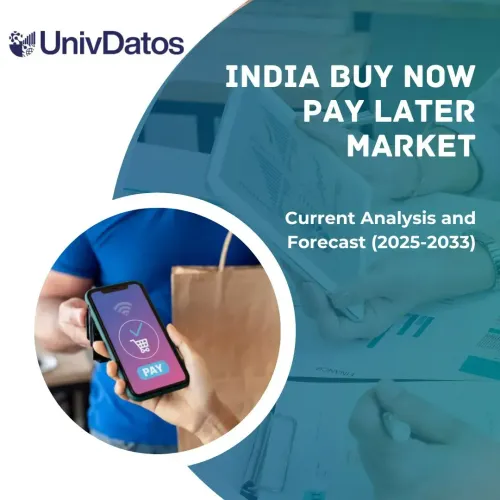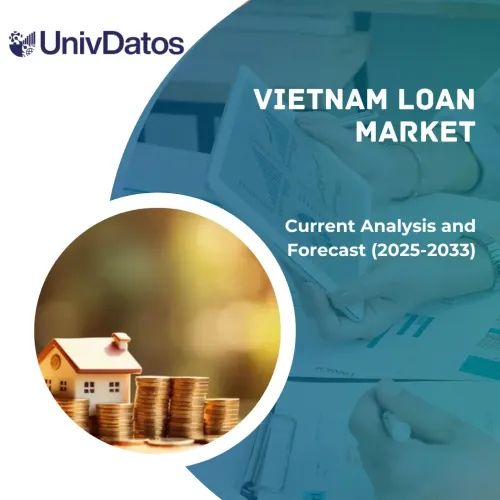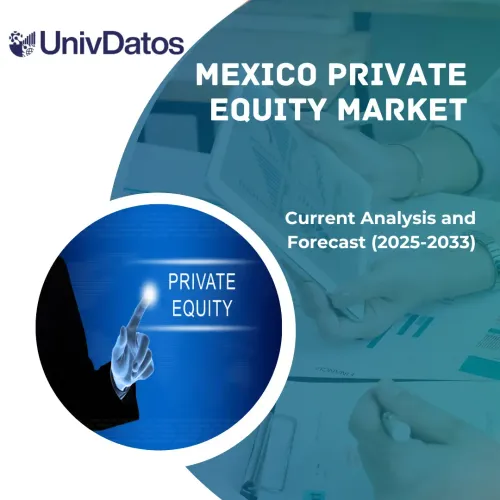- Home
- About Us
- Industry
- Services
- Reading
- Contact Us
MENA Fintech Market: Current Analysis and Forecast (2023-2030)
Emphasis on Deployment Mode (On-premises and Cloud); Application (Digital Payments, Insurance & Loan, Wealth Management, Others); Country.
Geography:
Last Updated:
Mar 2024
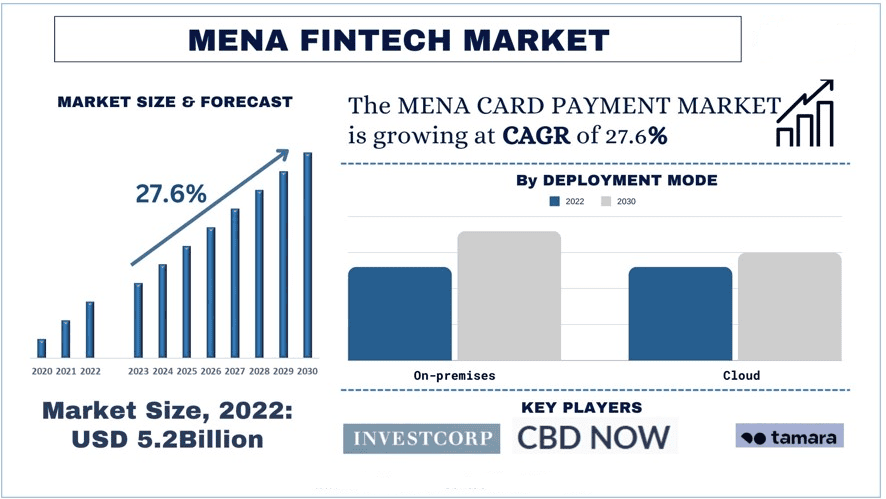
MENA Fintech Market Size & Forecast
The MENA Fintech market was valued at USD 5,274.26 million in the year 2022 and is expected to grow at a strong CAGR of around 27.6 % during the forecast period.
MENA Fintech Market Analysis
The region’s large unbanked and underbanked population presents a significant opportunity for fintech companies to expand access to financial services and drive financial inclusion. Additionally, increasing smartphone penetration and digital literacy among consumers facilitate the adoption of fintech solutions, such as mobile banking apps and digital wallets. Furthermore, strategic partnerships between fintech startups, financial institutions, and government agencies foster ecosystem development and collaboration, driving innovation and scalability. Moreover, favorable regulatory environments and initiatives such as regulatory sandboxes provide fintech companies with the necessary regulatory support to test and launch new products and services, stimulating investment and entrepreneurship in the MENA fintech market. For instance, in October 2022, Tamara conducted transactions of USD 267 million in 2021, and it already has three million active users, according to Forbes Middle East.
Some of the major players operating in the market include Investcorp, Emirates NBD Bank (P.J.S.C.), Tamara, Pepper, PayTabs, Tabby, NymCard, MashreqBank, ADIB,CBD NOW Several M&As along with partnerships have been undertaken by these players to facilitate customers with hi-tech and innovative products/technologies.
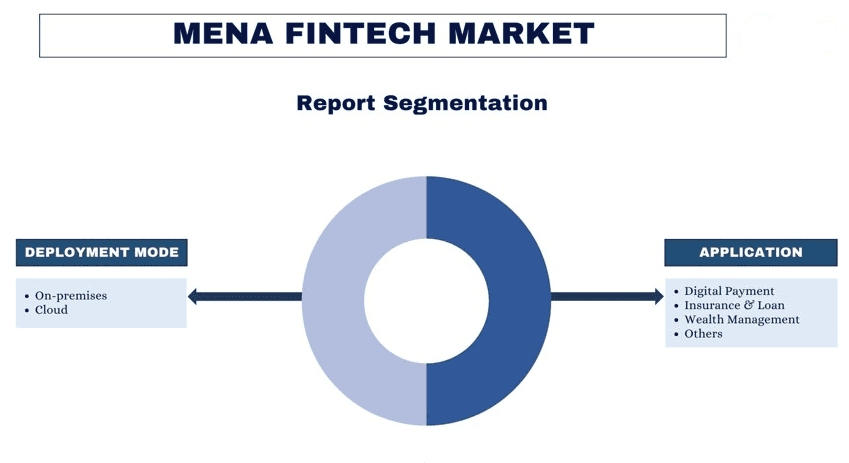
MENA Fintech Market Trend
“Amongst deployment mode, the on-premises category dominates the MENA fintech market.”
Based on the deployment mode, the market is segmented into on-premises and clouds. Among them, the on-premises category dominates the MENA fintech market due to security and regulatory concerns. Many financial institutions in the region prefer to have full control over their data and operations, especially when dealing with sensitive financial information. On-premises solutions provide a sense of security and reliability, which is particularly important in countries where trust in digital transactions may still be developing. Additionally, the MENA region has stringent regulatory requirements, and on-premises solutions allow organizations to ensure compliance while also addressing cybersecurity risks effectively.
“Amongst application, the digital payments category dominates the MENA fintech market.”
Based on the application, the market is segmented into digital payments, insurance & loan, wealth management, and others. Among them, the digital payments category dominates the MENA fintech market due to the region’s rapidly expanding digital ecosystem, driven by high smartphone penetration and a young population, which has created a fertile ground for digital payment solutions. Consumers in MENA countries increasingly prefer the convenience, speed, and security offered by digital payment methods over traditional cash transactions. Fintech companies are capitalizing on this trend by offering a wide range of digital payment solutions, including mobile wallets, peer-to-peer payment apps, and contactless payment technologies.
“Saudi is expected to grow at a significant rate during the forecast period.”
Fintech in Saudi Arabia is experiencing significant growth driven by several factors. Vision 2030’s emphasis on economic diversification and digital transformation has spurred fintech innovation in the kingdom. With a youthful population and high smartphone penetration, Saudi Arabia presents ample opportunities for fintech startups to thrive. The government’s supportive regulatory environment, including initiatives like the Financial Sector Development Program and the Regulatory Sandbox, encourages entrepreneurship and investment in the fintech sector. Moreover, the rise of digital payment solutions, peer-to-peer lending platforms, and robo-advisors reflects evolving consumer preferences and the demand for convenient, accessible financial services. As Saudi Arabia continues its journey towards becoming a digital economy, fintech is poised to play a pivotal role in driving financial inclusion, innovation, and economic growth in the kingdom. For instance, Saudi Arabia-based fintech Hakbah has raised 5.1 million USD in Series A funding, bringing the company’s funding raised to date to 9 million USD.
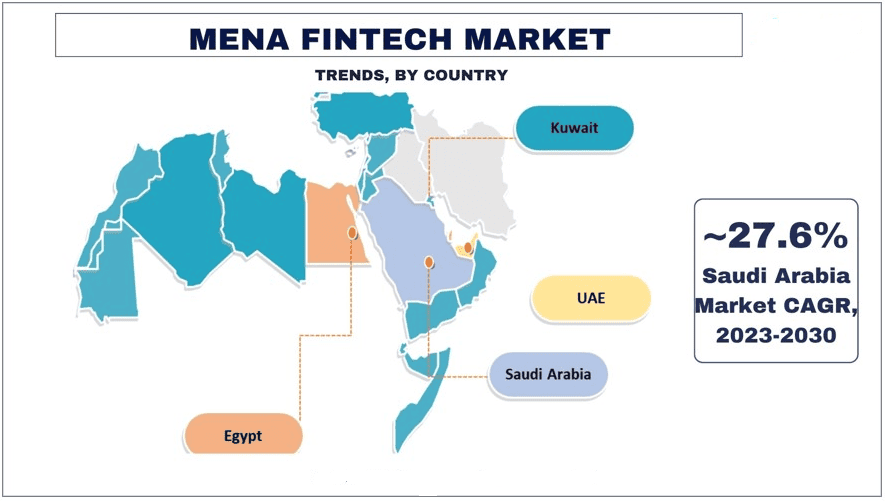
Reasons to buy this report:
- The study includes market sizing and forecasting analysis validated by authenticated key industry experts.
- The report presents a quick review of overall industry performance at one glance.
- The report covers an in-depth analysis of prominent industry peers with a primary focus on key business financials, product portfolios, expansion strategies, and recent developments.
- Detailed examination of drivers, restraints, key trends, and opportunities prevailing in the industry.
- The study comprehensively covers the market across different segments.
- Deep dive regional level analysis of the industry.
Customization Options:
The MENA fintech market can further be customized as per the requirement or any other market segment. Besides this, UMI understands that you may have your own business needs, hence feel free to contact us to get a report that completely suits your requirements.
Frequently Asked Questions (FAQ)
Table of Content
Research Methodology for the MENA Fintech Market Analysis (2023-2030)
Analyzing the historical market, estimating the current market, and forecasting the future market of the MENA fintech market were the three major steps undertaken to create and analyze the adoption of Home Healthcare in major countries in MENA. Exhaustive secondary research was conducted to collect the historical market numbers and estimate the current market size. Secondly, to validate these insights, numerous findings and assumptions were taken into consideration. Moreover, exhaustive primary interviews were also conducted, with industry experts across the value chain of the MENA Fintech market. Post assumption and validation of market numbers through primary interviews, we employed a top-down/bottom-up approach to forecasting the complete market size. Thereafter, market breakdown and data triangulation methods were adopted to estimate and analyze the market size of segments and sub-segments of the industry pertains to. Detailed methodology is explained below:
Analysis of Historical Market Size
Step 1: In-Depth Study of Secondary Sources:
Detail secondary study was conducted to obtain the historical market size of the MENA Fintech market through company internal sources such as annual reports & and financial statements, performance presentations, press releases, etc., and external sources including journals, news & and articles, government publications, competitor publications, sector reports, third-party database, and other credible publications.
Step 2: Market Segmentation:
After obtaining the historical market size of the MENA Fintech market, we conducted a detailed secondary analysis to gather historical market insights and share for different segments & and sub-segments for major regions. Major segments are included in the report as deployment mode and application. Further country-level analyses were conducted to evaluate the overall adoption of testing models in that region.
Step 3: Factor Analysis:
After acquiring the historical market size of different segments and sub-segments, we conducted a detailed factor analysis to estimate the current market size of the MENA Fintech market. Further, we conducted factor analysis using dependent and independent variables such as the deployment mode and application of the MENA Fintech market. A thorough analysis was conducted of demand and supply-side scenarios considering top partnerships, mergers and acquisitions, business expansion, and product launches in the MENA Fintech market sector across the globe.
Current Market Size Estimate & Forecast
Current Market Sizing: Based on actionable insights from the above 3 steps, we arrived at the current market size, key players in the MENA Fintech market, and market shares of the segments. All the required percentage shares split, and market breakdowns were determined using the above-mentioned secondary approach and were verified through primary interviews.
Estimation & Forecasting: For market estimation and forecast, weights were assigned to different factors including drivers & trends, restraints, and opportunities available for the stakeholders. After analyzing these factors, relevant forecasting techniques i.e., the top-down/bottom-up approach were applied to arrive at the market forecast for 2030 for different segments and sub-segments across the major markets globally. The research methodology adopted to estimate the market size encompasses:
- The industry’s market size, in terms of revenue (USD) and the adoption rate of the MENA Fintech market across the major markets domestically
- All percentage shares, splits, and breakdowns of market segments and sub-segments
- Key players in the MENA Fintech market in terms of products offered. Also, the growth strategies adopted by these players to compete in the fast-growing market.
Market Size and Share Validation
Primary Research: In-depth interviews were conducted with the Key Opinion Leaders (KOLs) including Top Level Executives (CXO/VPs, Sales Head, Marketing Head, Operational Head, Regional Head, Country Head, etc.) across major regions. Primary research findings were then summarized, and statistical analysis was performed to prove the stated hypothesis. Inputs from primary research were consolidated with secondary findings, hence turning information into actionable insights.
Split of Primary Participants in Different Regions
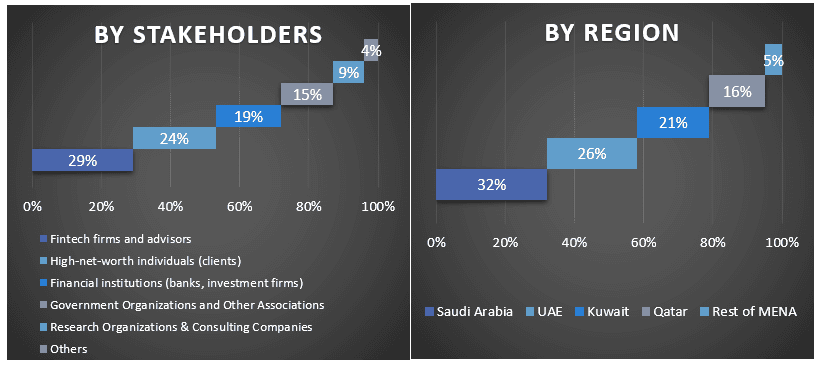
Market Engineering
The data triangulation technique was employed to complete the overall market estimation and to arrive at precise statistical numbers for each segment and sub-segment of the MENA Fintech market. data was split into several segments and sub-segments after studying various parameters and trends in the areas of the deployment mode and application in the MENA Fintech market.
The main objective of the MENA Fintech Market Study
The current & and future market trends of the MENA fintech market were pinpointed in the study. Investors can gain strategic insights to base their discretion for investments on the qualitative and quantitative analysis performed in the study. Current and future market trends determined the overall attractiveness of the market at a regional level, providing a platform for the industrial participant to exploit the untapped market to benefit from a first-mover advantage. Other quantitative goals of the studies include:
- Analyze the current and forecast market size of the MENA Fintech market in terms of value (USD). Also, analyze the current and forecast market size of different segments and sub-segments.
- Segments in the study include areas of the deployment mode and application.
- Define and analyze the regulatory framework for the surgical instrument
- Analyze the value chain involved with the presence of various intermediaries, along with analyzing customer and competitor behaviors of the industry.
- Analyze the current and forecast market size of the MENA Fintech market for the major region.
- Major countries of regions studied in the report include Asia Pacific, Europe, North America, and the Rest of the World
- Company profiles of the MENA Fintech market and the growth strategies adopted by the market players to sustain in the fast-growing market.
- Deep dive regional level analysis of the industry.
Frequently Asked Questions FAQs
Q1: What is the current market size and growth potential of the MENA Fintech market?
Q2: What are the driving factors for the growth of the MENA Fintech market?
Q3: Which segment has the largest share of the MENA Fintech market by application?
Q4: What are the emerging technologies and trends in the MENA Fintech market?
Q5: Which region will dominate the MENA Fintech market?
Q6: Who are the key players operating in the MENA Fintech market?
Related Reports
Customers who bought this item also bought

